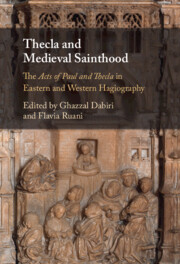Book contents
- Thecla and Medieval Sainthood
- Thecla and Medieval Sainthood
- Copyright page
- Contents
- Contributors
- Acknowledgments
- Abbreviations
- Introduction
- Part I An Act to Follow
- Part II An Act to Surpass
- Chapter 7 Thecla, the First Cross-Dresser?
- Chapter 8 From Diotima to Thecla and Beyond
- Chapter 9 Reception and Rejection
- Chapter 10 A Medieval Sufi Thecla?
- Afterword
- Appendix Summaries of Texts
- Index
- References
Chapter 8 - From Diotima to Thecla and Beyond
Virginal Voice in the Lives of Helia and Constantina
from Part II - An Act to Surpass
Published online by Cambridge University Press: 06 May 2022
- Thecla and Medieval Sainthood
- Thecla and Medieval Sainthood
- Copyright page
- Contents
- Contributors
- Acknowledgments
- Abbreviations
- Introduction
- Part I An Act to Follow
- Part II An Act to Surpass
- Chapter 7 Thecla, the First Cross-Dresser?
- Chapter 8 From Diotima to Thecla and Beyond
- Chapter 9 Reception and Rejection
- Chapter 10 A Medieval Sufi Thecla?
- Afterword
- Appendix Summaries of Texts
- Index
- References
Summary
How is it that female figures—though whether they are properly female is debatable—come to voice in Christian texts of late antiquity? How, in particular, do their voices enter into debates about desire, traditionally the province of masculine speech? And what do these virginal voices sound like? Are they distinct and recognizable to our reading ears? There is a story to be told, and it starts with Thecla. We might say that every Christian virgin who arrogates voice in some sense follows Thecla, speaking her desire in speech that both is and is not her own. Thecla, in other words, both inaugurates and serves as a figure for virginal voice in its startling, in-breaking forcefulness. But Thecla, however definitively novel, follows others as well. This chapter first backtracks to consider Thecla’s precursors, Diotima (Plato, Symposium) and Leucippe (Achilles Tatius, Leucippe and Clitophon). It then follows the reworking of those figures in the Acts of Thecla and Methodius’ Symposium respectively. Finally, it explores the legacy of Thecla in two little-known late ancient Latin dialogues that feature notably voluble virgins—the Lives of Saints Helia and Constantina, respectively.
- Type
- Chapter
- Information
- Thecla and Medieval Sainthood<I>The Acts of Paul and Thecla</I> in Eastern and Western Hagiography, pp. 233 - 255Publisher: Cambridge University PressPrint publication year: 2022



